» posted on Thursday, August 29th, 2013 by Linda Lou Burton
On Henry’s Behalf
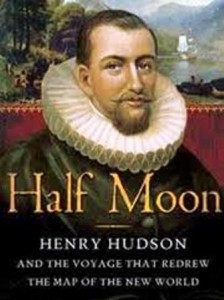 Linda Burton posting from Albany, New York – A lot of good things are discovered while somebody is looking for something else, like a passage to China. The Hudson River Valley is one such example. Now, the river was there eons before Englishman Henry Hudson sailed the Half Moon about as far north as where Albany sits today. That was 1609, when Henry was commissioned by the Dutch East India Company to find a way to get to Asia in a hurry, where they could trade for exotic spices. Henry wasn’t the first European to observe the river; in 1524 Italian explorer Giovanni da Verrazano (sailing for France) sailed all around the Upper Bay; he just didn’t go as far north as Henry did. And before Verrazano came along, the Iroquois, who lived along both banks of the lower portion of the river (now
Linda Burton posting from Albany, New York – A lot of good things are discovered while somebody is looking for something else, like a passage to China. The Hudson River Valley is one such example. Now, the river was there eons before Englishman Henry Hudson sailed the Half Moon about as far north as where Albany sits today. That was 1609, when Henry was commissioned by the Dutch East India Company to find a way to get to Asia in a hurry, where they could trade for exotic spices. Henry wasn’t the first European to observe the river; in 1524 Italian explorer Giovanni da Verrazano (sailing for France) sailed all around the Upper Bay; he just didn’t go as far north as Henry did. And before Verrazano came along, the Iroquois, who lived along both banks of the lower portion of the river (now 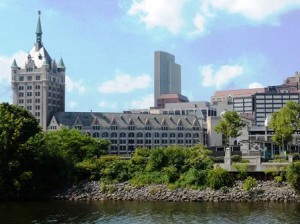 New Jersey and Manhattan) had already named the river “Muhheakantuck” – translate that to “river that flows two ways.” Because the Hudson River is subject to the rise and fall of the tides; as far north as Albany there is a four-foot tide twice a day. The river comes out of Henderson Lake in the Adirondack Mountains and flows 315 miles south before emptying into Upper New York
New Jersey and Manhattan) had already named the river “Muhheakantuck” – translate that to “river that flows two ways.” Because the Hudson River is subject to the rise and fall of the tides; as far north as Albany there is a four-foot tide twice a day. The river comes out of Henderson Lake in the Adirondack Mountains and flows 315 miles south before emptying into Upper New York 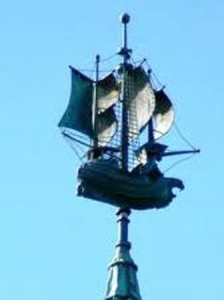 Bay. Its lower half is a tidal estuary; tidal water influences the flow as far north as Troy. I learned that today while sailing on the river myself, on a daily afternoon run of the Dutch Apple Cruises. The cruise started, appropriately enough, with a full-on description of the buildings of Albany alongside the river; with particular attention called to the 800-pound weathervane atop the SUNY headquarters. Hard to make out from a distance, but the narrator assured us it was an exact replica of Henry’s ship, the Half Moon.
Bay. Its lower half is a tidal estuary; tidal water influences the flow as far north as Troy. I learned that today while sailing on the river myself, on a daily afternoon run of the Dutch Apple Cruises. The cruise started, appropriately enough, with a full-on description of the buildings of Albany alongside the river; with particular attention called to the 800-pound weathervane atop the SUNY headquarters. Hard to make out from a distance, but the narrator assured us it was an exact replica of Henry’s ship, the Half Moon.
Wouldn’t you like to think, with all the fuss made over Henry today, and with all the adulation that is bestowed upon the “Hudson” name, that Henry himself profited wildly from his “discovery”? Sadly for Henry, such was not the case. Henry’s crew mutinied and left him behind; Henry was never heard from again. But that didn’t happen on the Half Moon, it happened on his fourth voyage in 1611, when he was sailing the Discovery for the British East India Company, far to the north in what is now Hudson Bay in Canada. The mutineers, anxious to return home after a long cold winter (he wanted to keep exploring), set Henry, his teen-age son John, and seven crew members adrift in a small boat with some provisions and sailed back to England. At least that’s how the journal kept by Abacuk Pricket, the ship’s navigator, described the events; who knows? If there is any solace in the story, only eight of the thirteen mutineers survived the return voyage; those eight were arrested and charged with murder. They were acquitted however, perhaps they were considered too valuable as 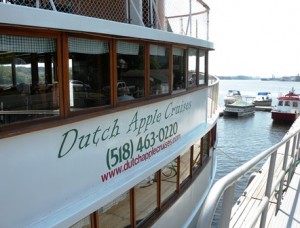 sources of information to be executed.
sources of information to be executed.
Henry’s legacy is profound, even if he never knew it – the discovery of that bay in Canada led to fur trade by the Hudson Bay Company for the next two hundred years, influencing the international boundaries of western North America. And Henry’s voyage up the Hudson River enticed the Dutch to come, and settle, and prosper, with the English soon to follow. That Half Moon weathervane is sort of like the credits rolling onscreen at the end of an epic movie, I thought, as our Dutch Apple Cruise headed downstream, past the Port of Albany. Discovered by Henry Hudson.
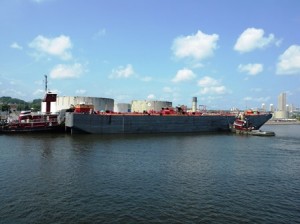 A fuel tanker was docked at the Port as we sailed by, two tugs awaited duty. It sat high, empty; the channel here is about 32 feet, our narrator explained. There is only one dam on the river, the Federal Dam at Troy, 153 miles north of the Battery in Manhattan; it marks the northern end of the Hudson River estuary. The lock, referred to as “E-1,” has a lift of 14 feet and is the first lock encountered by vessels passing from the Hudson River into the Great Lakes by way of the New York State Canal System. It is not part of the Erie Canal; it is maintained by the US Army Corps of Engineers. Just south of the Federal
A fuel tanker was docked at the Port as we sailed by, two tugs awaited duty. It sat high, empty; the channel here is about 32 feet, our narrator explained. There is only one dam on the river, the Federal Dam at Troy, 153 miles north of the Battery in Manhattan; it marks the northern end of the Hudson River estuary. The lock, referred to as “E-1,” has a lift of 14 feet and is the first lock encountered by vessels passing from the Hudson River into the Great Lakes by way of the New York State Canal System. It is not part of the Erie Canal; it is maintained by the US Army Corps of Engineers. Just south of the Federal 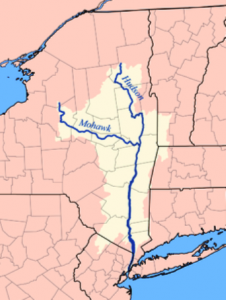 Dam and just north of Albany at Waterford the Mohawk River flows into the Hudson; it is a major tributary and has long been an important passageway through the Appalachians for transportation and migration. The entire system connects New York Harbor and Buffalo; the last stop for big ships is the Port of Albany.
Dam and just north of Albany at Waterford the Mohawk River flows into the Hudson; it is a major tributary and has long been an important passageway through the Appalachians for transportation and migration. The entire system connects New York Harbor and Buffalo; the last stop for big ships is the Port of Albany.
Private and public port facilities have existed in Albany since the 17th century; the current port was built in 1932 when Franklin D Roosevelt was governor. It had the largest grain elevator in the world at the time; it’s still the largest east of the Mississippi River with a 13,500,000-bushel grain capacity. Today’s Port has deep-water facilities on both banks of the river; the wharf length on the Albany side is 4,200 feet with four berths; on the Rensselaer side the length is 1,100 feet with one berth. US Customs and the US Department of Agriculture have offices at the Port; there 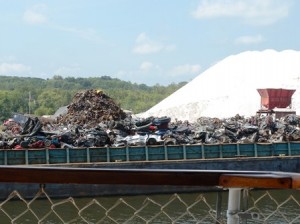 is a 12-acre road salt depot, and a 12-acre scrap yard. “See that white stuff?” Our narrator pointed to a giant mound of salt; next to that was a giant heap of scrapped automobiles. “The salt is for our roads this winter,” she explained. “It is imported; the scrap metal you see is exported.” We murmured at the oddity of importing salt; “It’s cheaper,” she explained. There are bulk liquid storage tanks, five transit sheds, and two back-up warehouses at the Port; “Can anyone identify the object that is partially visible between those two buildings?” Our narrator was testing us again; we could not. It was a blade for a windmill, soon to be transported to a windfarm in the Berkshires.
is a 12-acre road salt depot, and a 12-acre scrap yard. “See that white stuff?” Our narrator pointed to a giant mound of salt; next to that was a giant heap of scrapped automobiles. “The salt is for our roads this winter,” she explained. “It is imported; the scrap metal you see is exported.” We murmured at the oddity of importing salt; “It’s cheaper,” she explained. There are bulk liquid storage tanks, five transit sheds, and two back-up warehouses at the Port; “Can anyone identify the object that is partially visible between those two buildings?” Our narrator was testing us again; we could not. It was a blade for a windmill, soon to be transported to a windfarm in the Berkshires.
 We cruised for almost two hours; beyond the Port we passed home after beautiful home across wide expanses of lawn sweeping down to the river’s edge; “Wouldn’t you like to sled down that hill?” someone said. Yes, we all nodded. Or sit in a lawn chair and watch the world go by. We scanned the trees for eagles, spotting five in all, plus a few herons. “Wave at Bill!” was the instruction as we slowed in front of the Staats house on the east side of the river. The cutest little girl on the boat did just that as we heard the incredible story of the Staats family. Bill Staats has written a
We cruised for almost two hours; beyond the Port we passed home after beautiful home across wide expanses of lawn sweeping down to the river’s edge; “Wouldn’t you like to sled down that hill?” someone said. Yes, we all nodded. Or sit in a lawn chair and watch the world go by. We scanned the trees for eagles, spotting five in all, plus a few herons. “Wave at Bill!” was the instruction as we slowed in front of the Staats house on the east side of the river. The cutest little girl on the boat did just that as we heard the incredible story of the Staats family. Bill Staats has written a 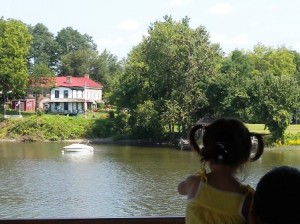 book about the eleven generations of his family who have occupied the house since it was built by Joachim Staats in 1696; it has never left the family and never will. (Worthy of a separate post; I made a note.) We had a little lesson in Dutch words; “kinder” mean children; “hook” means a spit of land, or area; “wyck” means a district; “kill” means creek. “The town of Fishkill isn’t where a lot of fish got killed,” the narrator laughed, “it means a creek there has a lot of fish in it.”
book about the eleven generations of his family who have occupied the house since it was built by Joachim Staats in 1696; it has never left the family and never will. (Worthy of a separate post; I made a note.) We had a little lesson in Dutch words; “kinder” mean children; “hook” means a spit of land, or area; “wyck” means a district; “kill” means creek. “The town of Fishkill isn’t where a lot of fish got killed,” the narrator laughed, “it means a creek there has a lot of fish in it.”
I wish we could have heard more stories and kept going south along this designated American Heritage River that has been nicknamed “America’s Rhine.” South for 124 miles through the 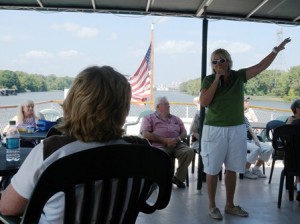 Hudson Valley past Kinderhook, and Martin Van Buren’s home; past Kingston, New York’s first capital city; past Franklin Roosevelt’s home and Presidential Library; past the Culinary Institute of America and all the vineyards; past West Point, and Sleepy Hollow, and Tarrytown, Washington Irving’s landscape; straight on past the New Jersey Palisades and into New York Harbor, where the cute little girl could wave at the Statue of Liberty.
Hudson Valley past Kinderhook, and Martin Van Buren’s home; past Kingston, New York’s first capital city; past Franklin Roosevelt’s home and Presidential Library; past the Culinary Institute of America and all the vineyards; past West Point, and Sleepy Hollow, and Tarrytown, Washington Irving’s landscape; straight on past the New Jersey Palisades and into New York Harbor, where the cute little girl could wave at the Statue of Liberty.
But on the other hand, I was happy to return to the dock in Albany and that Half Moon weathervane, where there is more to explore (on Henry’s behalf) than I’ll be able to see in a month of Dutch Sundays.
Dutch Apple Cruises, 518-463-0220, http://www.dutchapplecruises.com/
